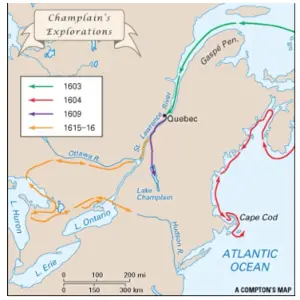The Explorer Samuel de Champlain
Samuel de Champlain was one of France's most famous explorers, most well-known for founding the city of Quebec. 
Champlain was born to Antoine Champlain and Marguerite Le Roy in 1574 in Brouage, a small town on France's west coast. Historians don't know much about his early life, other than that he probably learned the ropes of sailing quite early because his father and uncle were both mariners. Young Samuel was soon an accomplished navigator and creator of nautical charts. France was at war with Spain in the late 16th Century, and Champlain served in the army of France's King Henry IV. France won that particular war, and Champlain accompanied his uncle, Captain Provençal, on a journey aboard the St. Julien to return captured Spanish soldiers to Spain. The French ship then took on an assignment from the Spanish king, Philip III, to travel to the West Indies. Champlain was onboard for three voyages that lasted nearly two years, from 1599 to 1601, traveling around the Caribbean area and making notes, written and visual, of what he saw: land, plants, and animals. He is one of the first to have written of the efficacy of constructing a canal across Panama. Henry IV, the French king, was keen to have a settlement in the New World and sent an expedition under the command of François Gravé Du Pont. The ships set off from France on March 15, 1603. They passed what is now Newfoundland and on up the St. Lawrence River, anchoring in the harbor of Tadoussac near the mouth of the Saguenac River and ultimately reaching Montreal. The French explorers maintained relatively good relations with the Native Americans that they met; Champlain recorded information in his notes. In particular, the Frenchmen were intrigued by a great sea to the west that the Native Americans had mentioned. The ships returned to France in late 1603, and Champlain reported his findings to Henry IV. The king was so impressed that he commissioned another voyage, this one designed to last much longer, and urged Champlain to take part. That voyage, headed up by Pierre du Gua de Monts, left in 1604 and spent three years in what was called New France. They landed on the Nova Scotia coast and continued on to the Bay of Fundy, before settling in for the winter at Saint Croix Island. They explored down the eastern coastline of what is now North America as far as Cape Cod. They established Port Royal in 1606; this became the capital of Arcadia. 
Part of the financing of the voyage came from the a monopoly on the fur trade that Henry IV had granted to Monts. Times were tough in 1605, and Monts returned to France. Champlain and a few others stayed behind, exploring. They left for home in 1607. Champlain had not lost his thirst for exploration and was on yet another voyage to the New World in 1608, this time as captain of the Don-de-Dieu, one of the three ships making the voyage. They achieved their goal of establishing a settlement, at a place that the locals called kebec, which meant "the narrowing of the waters." Champlain spelled it Quebec. They built a fort to protect the new settlement. Champlain had become friendly with members of the Algonquin and Huron tribes, and those two tribes asked Champlain and his men to aid them in a struggle against the Iroquois in July 1609. The French did so, and Champlain also explored more of the land around Quebec. In fact, he was the first European to map the lake that now bears his name: Lake Champlain. He participated in two more military campaigns, in 1610 and 1615. An injury he suffered in the third campaign, taking an arrow to the knee, made him unable to walk and forced him to remain in the Lake Huron region for a winter; during this time, he established friendly relations with two more Native American tribes, the Nipissing and the Odawa. King Henry IV died in 1610, and the new king was his son, the young Louis XIII. This king named Champlain his lieutenant in New France in 1611. Champlain traveled back and forth between France and New France several times while also exploring more and more territory in New France. (In all, he crossed the Atlantic Ocean 21 times.) In 1615, he saw the Great Lakes for the first time when he reached the eastern edge of what is now Lake Huron. (This turned out to be the western sea to which the Native Americans had referred.) 
He returned to France in 1616 and stayed there for a few years, writing up accounts of his voyages and including maps and sketches of the animals, plants, and people that he encountered. He went back to New France in 1620, this time taking his wife, Hélène, with him. They stayed for a number of years. Champlain wanted to expand Quebec, already the center of the French fur trade, into the center of New France; the French king agreed. In 1628, Champlain was named the deputy of a new organization created by France's Cardinal Richelieu, the Company One Hundred Associates. Louis XIII and Cardinal Richelieu gave this company ownership of all lands between Florida and the Arctic Circle, with a near-monopoly on trade. English soldiers disrupted Champlain's dream of a vibrant Quebec in 1629, when they occupied it, as part of a wider war with France. The English left in 1632, and France retook control. Champlain made what turned out to be his last trip to New France in 1633. He died two years later, of a stroke. |
|
Social Studies for Kids
copyright 2002–2024
David White




